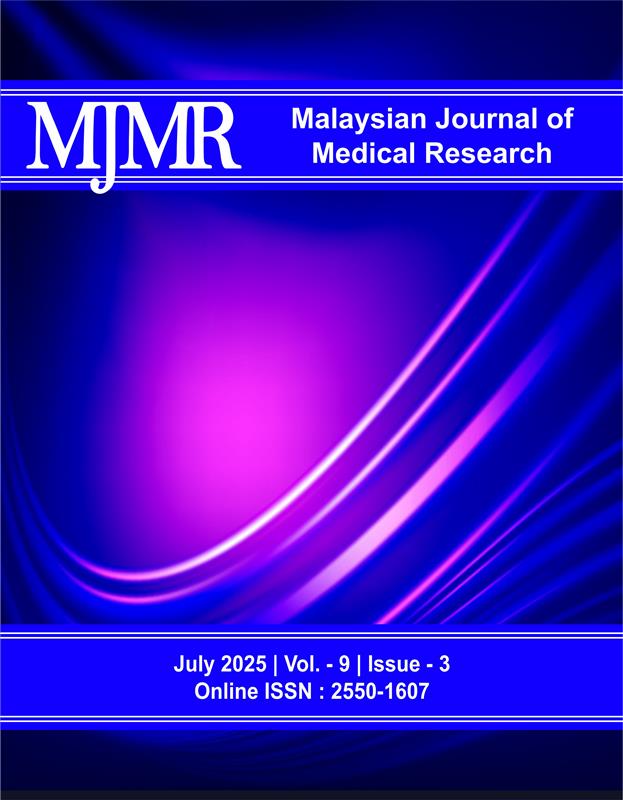The Relationship between Burnout and Interpersonal Communication in Medical Inpatient Nurses
DOI:
https://doi.org/10.31674/mjmr.2025.v09i03.004Abstract
Introduction: Nursing management involves organising, supervising, and developing the skills of nurses to ensure optimal service standards. Burnout, characterised by significant physical, mental, and emotional exhaustion, can negatively impact individual performance. Interpersonal communication is one of the contributing factors to burnout, accounting for 28.7%, with the remaining 71.3% attributed to other factors. If left unaddressed, burnout can adversely affect the quality of nursing care. This study aims to determine the relationship between burnout and interpersonal communication among inpatient medical nurses. Methods: This study utilised a quantitative research method with a descriptive correlational research design and a cross-sectional approach. The Spearman Rank statistical test was employed to analyse the data. The sampling technique used was Total Sampling, and the analysis was carried out through bivariate analysis. Results: The majority of respondents were aged 31-40 years (standard deviation = 7.074), with most being female (92.9%, n = 78). Most respondents held a diploma in nursing (D3) (55.9%, n = 47). In terms of marital status, 83.3% (n = 70) were married, and the majority had more than 10 years of work experience (47.6%, n = 40). Regarding burnout dimensions, 81.0% of respondents experienced low emotional exhaustion, 79.8% showed low depersonalisation, and 100% exhibited high personal achievement. Statistical analysis revealed a negative relationship between burnout and interpersonal communication, with a p-value of 0.000 < 0.05. Spearman Rank correlations were as follows: -0.348 for emotional exhaustion, -0.452 for depersonalisation, and -0.568 for personal achievement. Conclusion: The study concluded that there is a significant relationship between burnout and interpersonal communication among inpatient medical nurses. This highlights the importance of addressing burnout to improve communication and overall nursing care quality.
Keywords:
Burnout, Implementing Nurse, Interpersonal CommunicationDownloads
References
Agung Yudhianto, K. (2023). Burnout ditinjau dari komunikasi interpersonal pada perawat IGD [Burnout reviewed from interpersonal communication in emergency room nurses]. Profesi (Profesional Islam): Media Publikasi Penelitian, 20(2), 139–144. https://doi.org/10.26576/profesi.v20i2.162
Astuti, I., Wicaksono, L., Maryuni, S., & Putri, A. (2022). Identifikasi permasalahan pada mahasiswa di Universitas Tanjungpura [Identification of problems in students at Tanjungpura University]. Journal Education and Development, 10(3). Retrieved from: https://journal.ipts.ac.id/index.php/ED/article/view/4286. Accessed on 27th May 2024.
Cañadas-de la Fuente, G. A., Albendín-García, L., Ortega-Campos, E., & de la Fuente-Solana, E. I. (2018). Nurse burnout in critical care units and emergency departments: intensity and associated factors. Emergencias: Revista de la Sociedad Espanola de Medicina de Emergencias, 30(5), 328-331. Retrieved from: https://europepmc.org/article/med/30260117. Accessed on 24th May 2024.
Coster, S., Watkins, M., & Norman, I. J. (2017). What is the impact of professional nursing on patients’ outcomes globally? An overview of research evidence. International Journal of Nursing Studies, 78, 76–87. https://doi.org/10.1016/j.ijnurstu.2017.10.009
Febriyani, M. W., Masitoh, R., & Kurniasih, Y. (2024). Hubungan komunikasi interpersonal dengan kejadian burnout perawat di ruang rawat inap RS PKU Muhammadiyah Yogyakarta [The relationship between interpersonal communication and the incidence of nurse burnout in the inpatient ward of PKU Muhammadiyah Hospital Yogyakarta] (Doctoral dissertation, Universitas' Aisyiyah Yogyakarta). Retrieved from: https://digilib.unisayogya.ac.id/7071/. Accessed on 27th June 2024.
Geun, H. G., & Park, E. (2019). Influence of emotional intelligence, communication, and organizational commitment on nursing productivity among Korean nurses. Journal of Korean Academy of Community Health Nursing, 30(2), 226-233. https://doi.org/10.12799/jkachn.2019.30.2.226
Gül, N. (2021). Relationship between emotional intelligence and communication skills of healthcare workers. Akademik Araştırmalar ve Çalışmalar Dergisi, 13(25), 457–465. https://doi.org/10.20990/kilisiibfakademik.972072
Lastari, R. F., Sari, G., Sari, S. M., Erianti, S., & Rajunitrigo, R. (2024). Perception of burnout syndrome among nurses providing nursing care in the emergency room at a hospital in Riau Province. Healthcare in Low-resource Settings, 12(3). https://doi.org/10.4081/hls.2024.11815
Ma'arif, S., & Eliyana, A. (2019). Job Satisfaction and Organizational Commitment Effect in the Transformational Leadership Towards Employee Performance. European Research on Management and Business Economics, 25(3), 144–150. https://doi.org/10.1016/j.iedeen.2019.05.001
Mahvar, T., Mohammadi, N., Seyedfatemi, N., & Vedadhir, A. (2020). Interpersonal communication among critical care nurses: An ethnographic study. Journal of Caring Sciences, 9(1), 57–64. https://doi.org/10.34172/jcs.2020.009
Marquis, B. L., & Huston, C. J. (2017). Leadership roles and management functions in nursing (9th ed.). Wolters Kluwer. USA. Retrieved from: http://repository.stikesrspadgs.ac.id/400/1/leadership%20role%20in%20nursing9th.pdf. Accessed on 24th May 2024.
Maslach, C., & Leiter, M. P. (2016). The burnout challenge: Managing people’s relationships with their jobs. Harvard University Press, London, UK.
Masitoh, Z., Putri, T. H., & Fahdi, F. K. (2022). Hubungan Self-Efficacy dengan Academic Burnout saat Pandemi COVID-19 pada Mahasiswa Keperawatan Universitas Tanjungpura Pontianak [The Relationship between Self-Efficacy and Academic Burnout during the COVID-19 Pandemic in Nursing Students at Tanjungpura University, Pontianak]. Malahayati Nursing Journal, 4(12), 3243-3257. https://doi.org/10.33024/mnj.v4i12.7469
Mirnawati, M. (2013). Hubungan komunikasi interpersonal perawat dengan kepuasan pasien rawat inap di ruang Cempaka RSUD AW Sjahranie Samarinda [The relationship between interpersonal communication of nurses and the satisfaction of inpatients in the Cempaka Ward of AW Sjahranie Regional Hospital, Samarinda]. Psikoborneo: Jurnal Ilmiah Psikologi, 1(4), 241–249. Retrieved from: https://e-journals.unmul.ac.id/index.php/psikoneo/article/view/3522. Accessed on 27th May 2024.
Monica, M., & Sureskiarti, E. (2022). Hubungan Model Praktik Keperawatan Profesional terhadap Pengendalian Mutu Keperawatan di Unit Pelayanan Kesehatan: Literature Review [The Relationship of Professional Nursing Practice Model to Nursing Quality Control in Health Service Units: Literature Review]. Borneo Studies And Research, 3(3), 2692-2707. Retrieved from: https://journals.umkt.ac.id/index.php/bsr/article/view/2532. Accessed on 27th May 2024.
Juanamasta, I. G., Aungsuroch, Y., Gunawan, J., Dino, M. J., & Polsook, R. (2024). Prevalence of burnout and its determinants among Indonesian nurses: a multicentre study. Scientific Reports, 14(1), 31559. https://doi.org/10.1038/s41598-024-63550-6
Surya, P. A. A. S., & Adiputra, I. N. (2017). Hubungan lama bekerja dengan burnout pada perawat di ruang rawat anak RSUP Sanglah [Relationship between length of work and burnout in nurses in the pediatric ward of Sanglah General Hospital]. Jurnal Medika Udayana, 6(4), 10–19. Retrieved from: https://ojs.unud.ac.id/index.php/eum/article/view/29321. Accessed on 14th June 2024.
Dudija, N., & Putri, R. A. (2025). The Influence of Workload Towards Burnout Among Generation Z Employees in Indonesia: The Mediation Role of Work Stress. Journal of Economics, Business, and Accountancy Ventura, 27(3), 355-372. https://doi.org/10.14414/jebav.v27i3.4519
Utami, R. S., Pujianto, A., Setyawan, D., Naviati, E., & Rochana, N. (2020). Critical care nurses’ experiences of end-of-life care: a qualitative study. Retrieved from: https://repository.unar.ac.id/jspui/handle/123456789/746. Accessed on 24th May 2024.
Widyakusumastuti, R., & Fauziah, N. (2016). Hubungan antara komunikasi interpersonal dengan burnout pada perawat rumah sakit umum daerah (RSUD) kota semarang [The relationship between interpersonal communication and burnout in nurses at the Semarang City Regional General Hospital (RSUD)]. Jurnal Empati, 5(3), 553-557. https://doi.org/10.14710/empati.2016.15403
WHO (World Health Organization). (2019). Burn-out an occupational phenomenon: International Classification of Diseases. Retrieved from: https://www.who.int/news/item/28-05-2019-burn-out-an-occupational-phenomenon-international-classification-of-diseases. Accessed on 14th May 2024.
Published
How to Cite
Issue
Section
License
Copyright (c) 2025 Malaysian Journal of Medical Research (MJMR)

This work is licensed under a Creative Commons Attribution-NonCommercial-NoDerivatives 4.0 International License.























